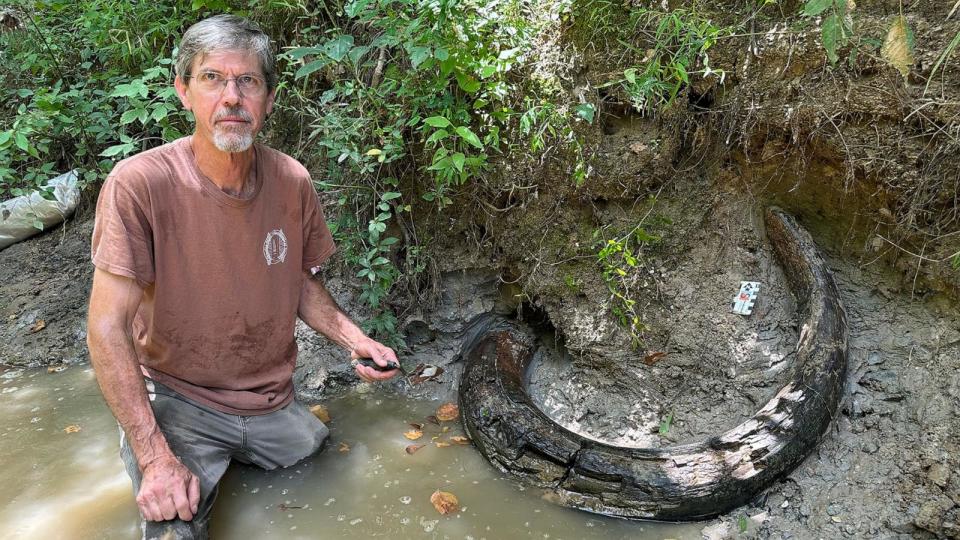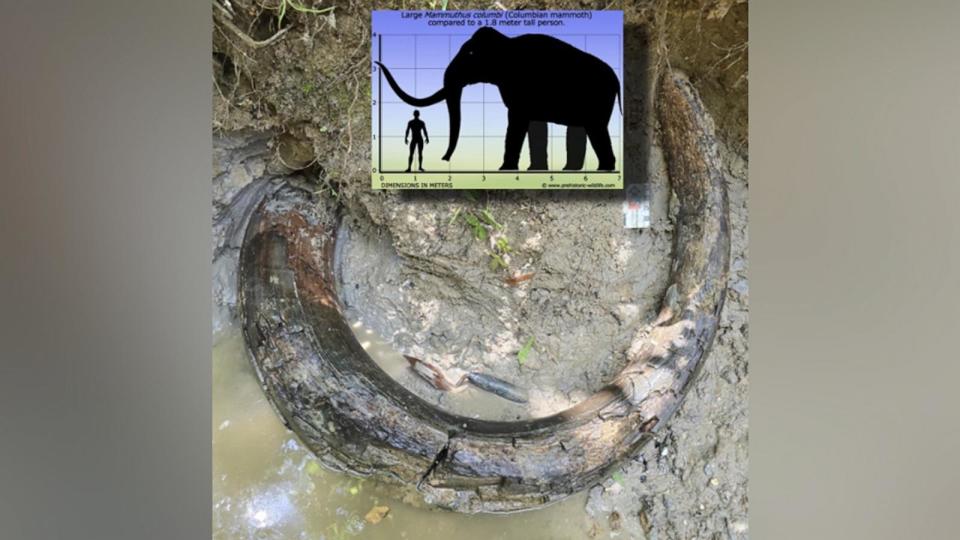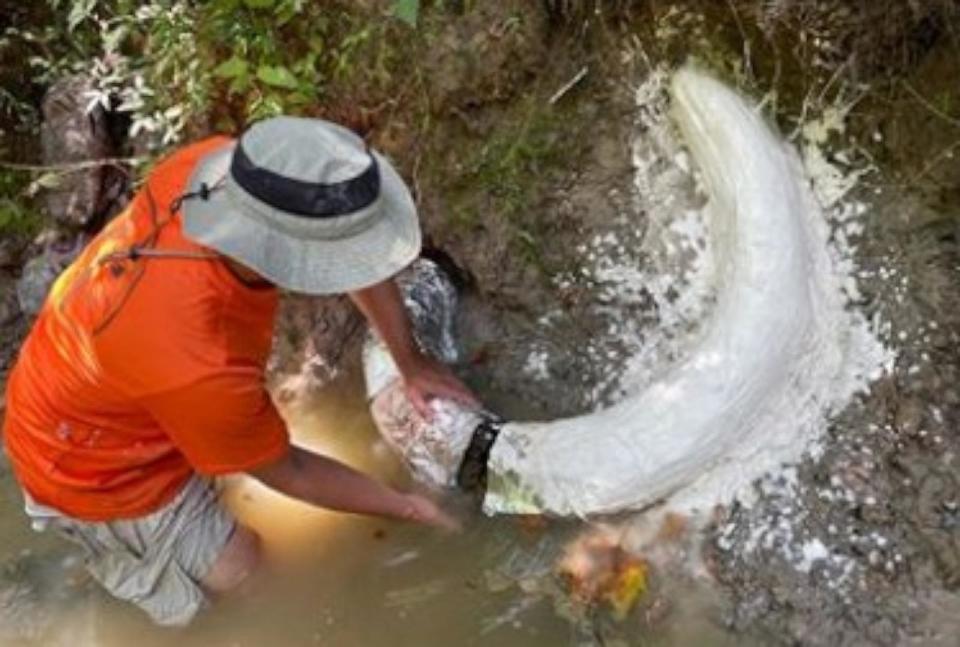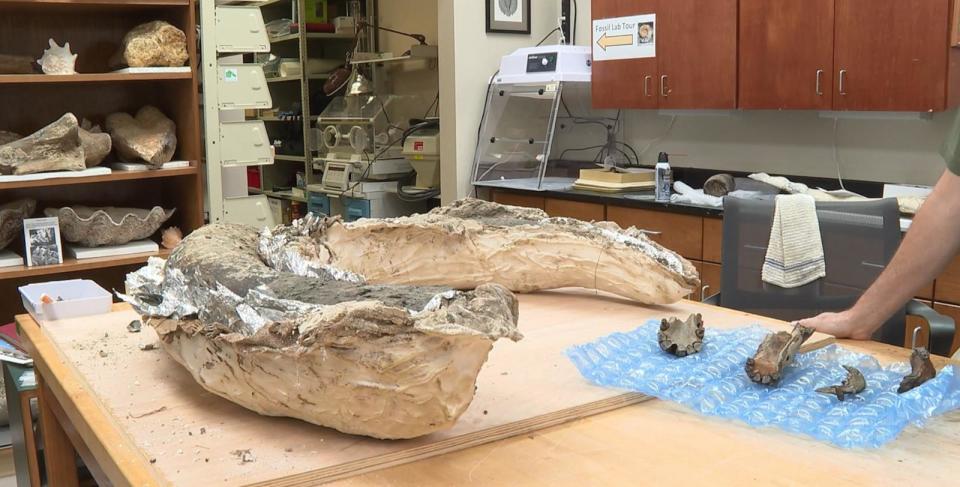Eddie Templeton was wading through a creek in rural Mississippi during one of his regular fossil hunts when he made a mammoth discovery.
The avid fossil collector spotted a tusk sticking out of the creek bank in Madison County. He knew it was likely from the last Ice Age, but soon discovered he had found a fully intact tusk that once belonged to a Columbian mammoth.
“Probably two-thirds of it was visible. I thought, Wow, that’s a lot of tusk,” Templeton told ABC News.

While excavating it, Templeton noticed that the 7-foot-long tusk was still intact, “which was unusual.”
According to the Mississippi Department of Environmental Quality (MDEQ), the discovery of the intact mammoth tusk is “an extremely rare find for Mississippi.”
“Most of the tusked ivory fossils found in the state are only fragments and likely belong to the more common mastodon,” MDEQ said in a statement Friday.


The massive Columbian mammoth, a proboscidea related to modern elephants that lived during the Pleistocene, could grow up to 15 feet tall at the shoulder and weigh more than 10 tons. The discovery of the tusk is the first of its kind for the area, according to MDEQ, which said mammoths “are much less common in Mississippi because they were open grassland grazers and would have been at home only in a select few environments, particularly the prairie regions of Mississippi.”
Templeton said he was initially disappointed with the conditions in the creek, given the high water at the time. He had only been out for about 30 minutes on the morning of Aug. 3 when he found the tusk while searching the bank for fossils.
He sent a photo of the tusk to geologists working for the state and to George Phillips, the curator of paleontology at the Mississippi Museum of Natural Science in Jackson. Based on the curvature of the tusk, it was suspected that it came from a Columbian mammoth, rather than the more common mastodon, MDEQ said.
“This thing is almost a full circle, the curvature of it,” Templeton said. “I’ve never found a whole mastodon tusk, but I’ve found some pretty big pieces, and they’re clearly not that curved.”


MORE: Stegosaurus skeleton nicknamed ‘Apex’ sells for record $44.6 million at Sotheby’s
The huge fossil had to be removed as quickly as possible, otherwise the heat would dry it out and the tusk could break.
“There was kind of a sense of urgency to get it out because once it starts to dry out, this process of delamination starts, and it can go downhill pretty quickly,” Templeton said. “Our intention from the beginning was to protect it, get it out of the creek and into a better environment to protect it.”
Templeton knew it was too big to dig himself, and was soon joined by the Mississippi State Geological Survey’s MDEQ paleontology team. They spent the rest of the day removing the fossil from the dike.


After being photographed in situ, the fossil was covered in a protective plaster casing to stabilize it during removal, MDEQ said. The fossil, which weighed about 600 pounds in its plaster casing, was then hoisted onto a makeshift stretcher made from an ATV ramp, MDEQ said. It was then driven up a steep incline onto a truck and transported to the Mississippi Museum of Natural Science for conservation and research.
“Eddie’s discovery provides a rare glimpse into the Columbian mammoths that once roamed Madison County along the Jackson Prairie in central Mississippi,” MDEQ said.
The tusk belonged to an adult mammoth that lived toward the end of the Pleistocene and could be as old as 75,000 years or as old as 11,500 years, Phillips told ABC News. It was confirmed as a mammoth tusk because of the “extreme curvature, almost a complete circle,” characteristic of the proboscidean, he said.
The fossil is currently drying under optimal conditions. After a few months, it will be treated with a compound “very similar to that used in laminating safety glass in car and truck windshields,” Phillips said.
Once the animal is cleaned and preserved, the museum hopes to get a better estimate of the mammoth’s age when it died by counting the rings where the tusk is broken in the middle, he said.
The museum also hopes to put the fossil on display, with a temporary exhibit possibly as early as March 2025, Phillips said.
MORE: Largest stegosaurus fossil ever found auctioned by Sotheby’s in New York
Templeton has been searching for fossils for decades, and his Ice Age finds include the bones of a giant beaver and a saber-toothed cat. He counts a mammoth tusk among his two most impressive finds — the other is the complete lower jaw of a mastodon, “with teeth in it and everything.” He found it in 1996 and donated it to the Mississippi Museum of Natural Science.
“It’s fascinating to me,” he said. “It’s hard for someone not to be interested in that stuff once they see it.”
He said he is pleased that the discovery is drawing attention to Mississippi scientists, the museum and the region’s rich geologic history.
“Most people don’t even know this stuff exists,” he said.


The mammoth is believed to have died near where the tusk was found and the remains were then carried down the riverbed, MDEQ said. The tusk was covered in alluvium, possibly during a major flood, MDEQ said. Phillips told ABC Jackson affiliate WAPT that the tusk would likely have been buried “relatively immediately” to be so well preserved.
Templeton, who says he goes fossil hunting every few weeks, thinks he’ll return to the creek where he found the tusk next weekend for his next fossil hunt.
“Now I want to find a mammoth tooth,” he said. “Now that I know a mammoth died here, I’m optimistic that I’ll find a mammoth tooth.”
7-Foot Long Mammoth Tusk Found in Mississippi Creek in Rare Discovery originally appeared on abcnews.go.com